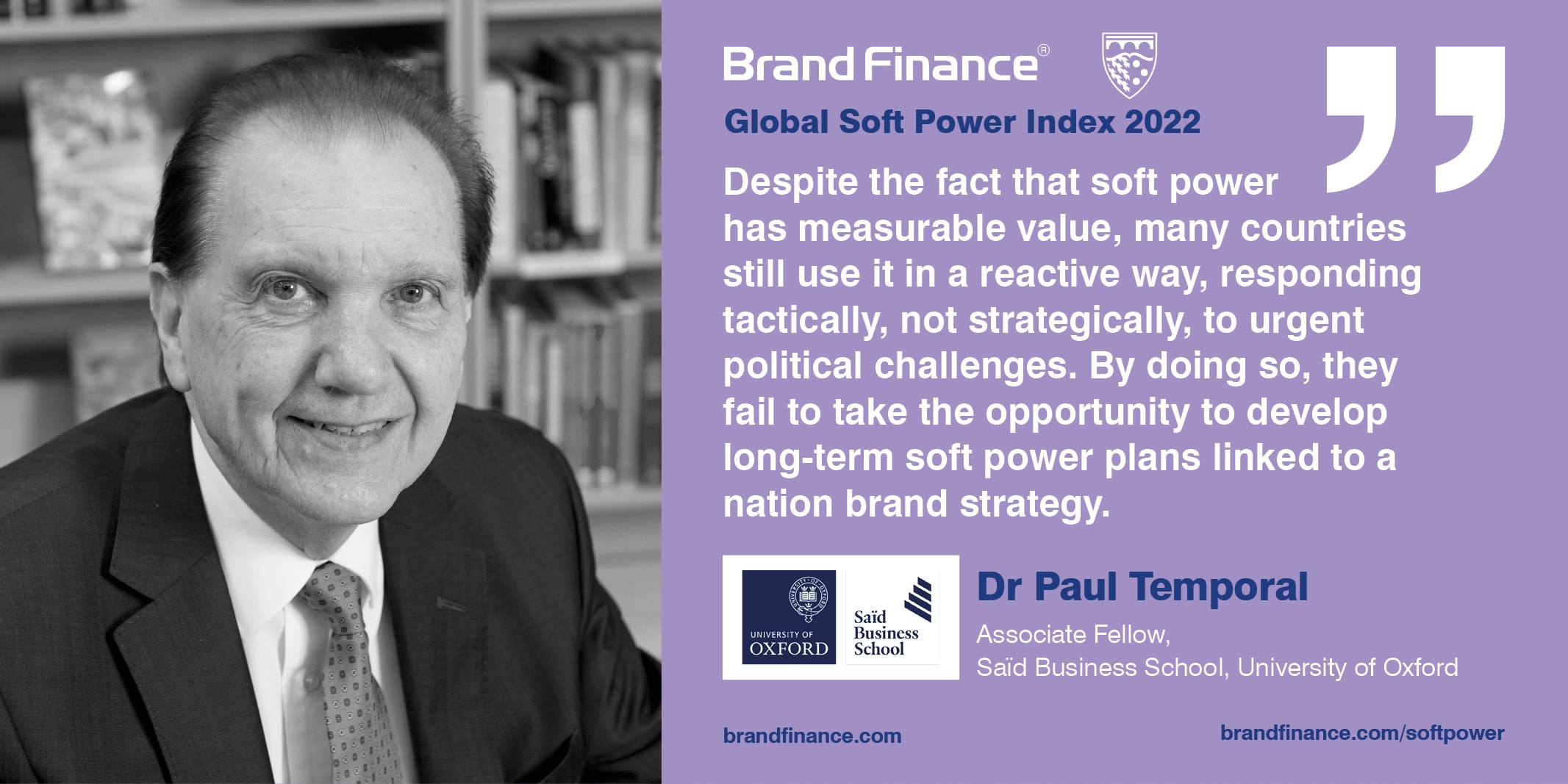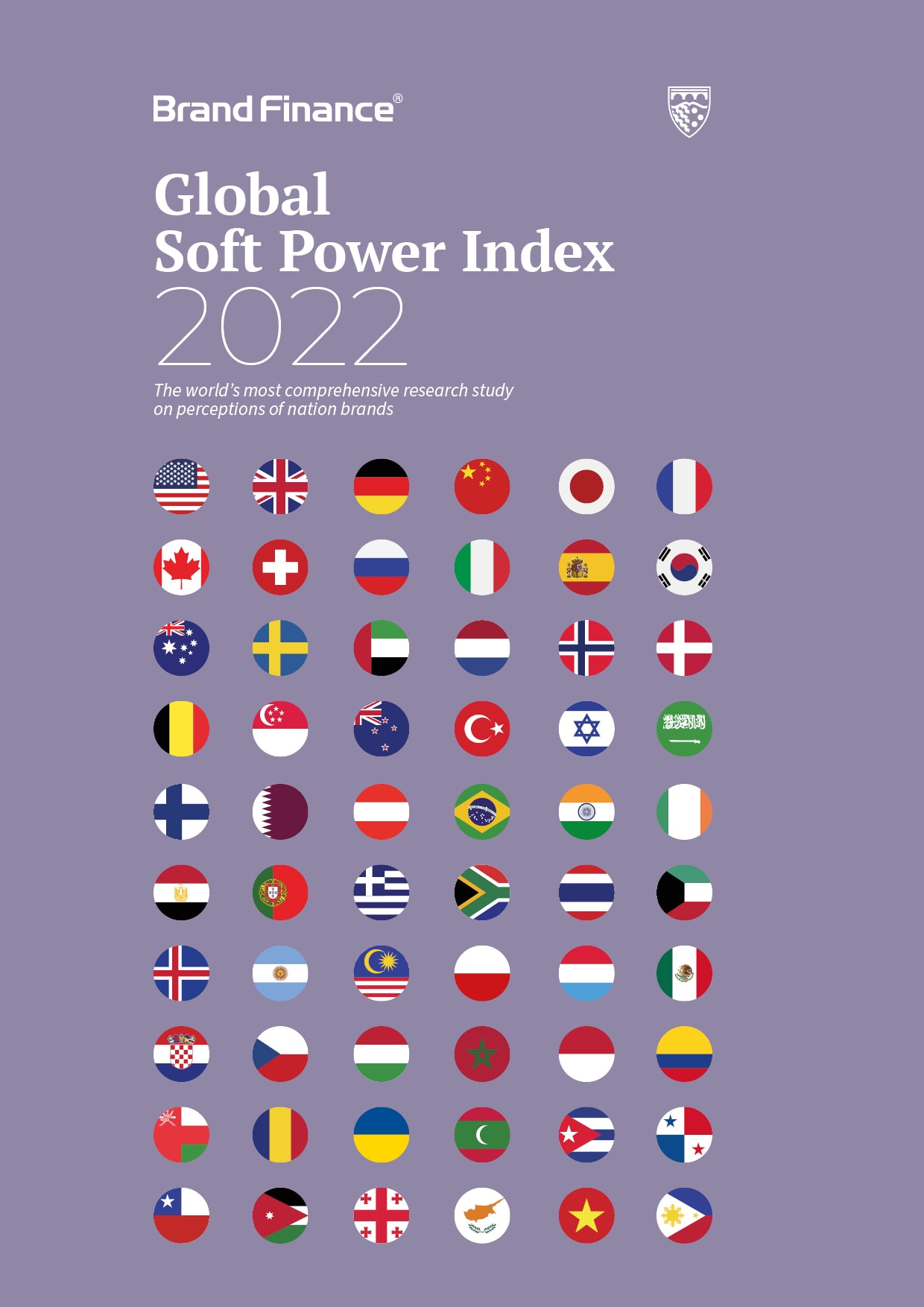This article was originally published in the Global Soft Power Index 2022.

Few countries have a comprehensive, integrated nation brand strategy or soft power strategy and it is limiting their chances of success. Inadequate brand management structures are partially to blame.
Nation branding is concerned largely with the effect of a country’s image on the economy. A strong, positive nation brand encourages inward investment and export growth; it attracts tourists and talent. Soft Power, on the other hand, is the ability to persuade and influence, mainly in the international arena. It can be a strong driver of nation branding success at all levels, and eight of the top 10 countries in the Global Soft Power Index 2022 appear also in the Nation Brand Index 2021 top ten.
Despite the fact that soft power has measurable value, many countries still use it in a reactive way, responding tactically, not strategically, to urgent political challenges. By doing so, they fail to take the opportunity to develop long-term soft power plans linked to a nation brand strategy.

There are two main reasons why this happens: the wrong choice of brand architecture and inadequate brand management structure.
In the corporate world, it is established practice to develop a master brand strategy and link this to an ‘architecture’ of sub-brands and product brands. So it should be in the public sector, as all brands then gain trust, strength, and value over time.
What we find, though, is that most countries start to build a nation brand identity based on only one sector – often tourism, which is the most visible and measurable activity. And, having started on this trajectory, they inevitably continue with a sector-by-sector, sub-brand approach. This can lead to competition between sub-brands for investment and the ‘ear’ of government, which often results in wastage and/or duplication of investment funding. There can even be competition within sub-brands and product brands such as national tourism, state tourism, or tourism to city and place destinations.
So why does this happen? I think an all-embracing nation brand strategy is often seen as ‘mission impossible’; getting all stakeholders involved and in agreement on development and implementation seems just too difficult.
Further, developing and managing a nation brand is a long-term process, with results also taking a long time to appear. Political thinking and government budgets are short term, driven by the need to demonstrate returns on investment and improvement in fiercely competitive markets.
But the only way to build a powerful nation brand is to use the master brand approach, and the most effective way to accommodate this is to create a strong, powerful, and inclusive brand management structure at a high level; a structure with the power to effect change, inclusivity, and a broad remit. There have been some useful models that testify to the success of structured brand management such as those in South Korea, Switzerland, and Australia.
The South Korean Presidential Council on Nation Branding (PCNB) was founded in 2009 as a result of a nation brand research study that ranked Korea 39th, behind countries including Mexico, India, China and Egypt on various brand strength factors such as cultural appeal, governance, demand for exports and others, even though Korea was the 13th most powerful economy in the world.
PCNB comprised 47 members (16 senior government officials including eight Ministers, and 31 representatives from the private sector), with five teams responsible for international co-operation, corporate and information technology, culture and tourism, the global community, and overall co-ordination. It played a central role in reorganizing and managing South Korea's branding activities and creating positive images abroad. With a nation brand vision of “A Reliable and Dignified Korea” and core values of “Sharing, Consideration, Respect, Communication and Unity”, its strategy was designed also to reinforce and develop soft power. South Korea is now ranked 12th in the GSPI 2022 and 10th in the NBI 2021.
Australia has a Minister for Trade, Tourism and Investment and this integrated portfolio is helpful in lowering intra-brand competition and ensuring buy-in across industries and sectors. Reporting to the Minister is a National Brand Advisory Council whose role is to provide strategic advice and leadership and is made up of 12 influential public and private sector leaders from diverse industries. The Council is supported by a Nation Branding Expert Working Group that provides branding and creative guidance, so completing a workable nation brand management structure. Australia is 13th in the GSPI 2022 and 11th in the NBI 2021.
Switzerland does not have a hugely powerful economy compared to some nations, and so relies for its nation brand development heavily on soft power, through Presence Switzerland, a body that monitors and supports the national identity and image abroad. It was created by the Swiss Federal Parliament in 2000 as a decentralized administrative unit within the Federal Department of Foreign Affairs (FDFA) and was given authority by the Federal Act on the Promotion of Switzerland’s image abroad. Switzerland is ranked 8th in the GSPI and 14th in the NBI. Under the NBI 2021 methodology, Switzerland was named the world’s strongest brand.
If poor brand architecture choices and lack of strong brand management are barriers to success, then countries must combine nation branding and soft power data and activities for use in developing an integrated nation-brand strategy. Well-organised brand management is essential to navigate these tricky waters, and there must be multi-sector buy-in, control, consistency, and measurement. The cases mentioned highlight the need to drive and manage a nation’s brand at the highest level, and to include all stakeholders in its development and management. It is not an impossible task.

